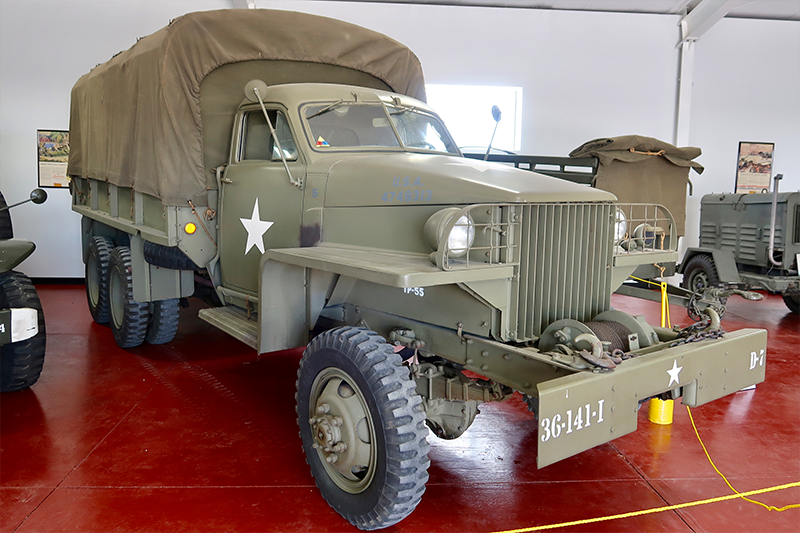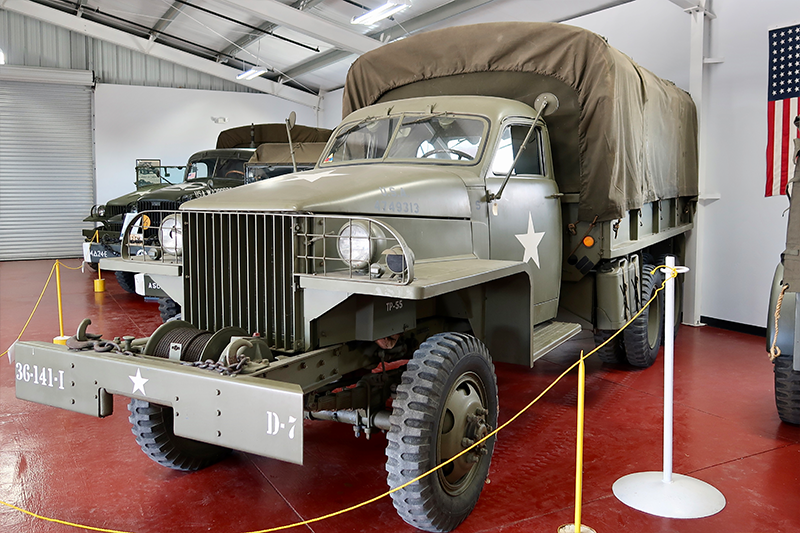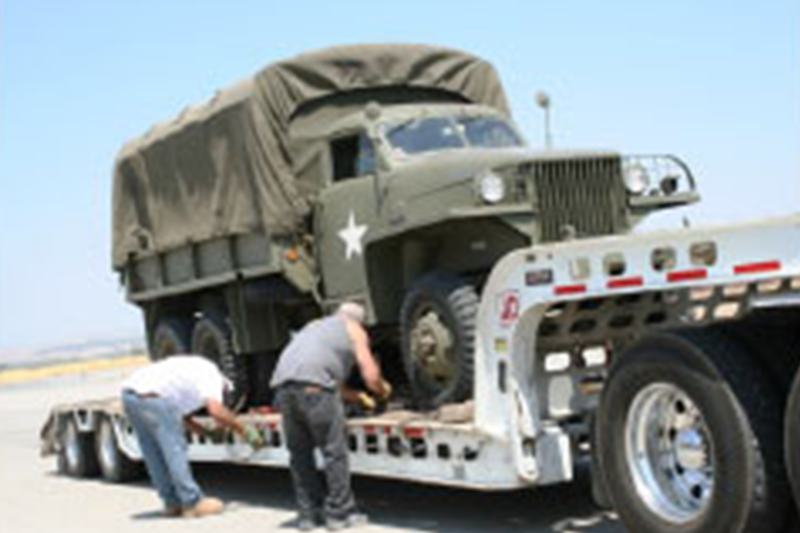Specifications
| GENERAL DATA | |||
|---|---|---|---|
| Crew | 2 | ||
| Weight | Net | (lb) | |
| Payload | (lb)2,300 | kg | |
| Gross | (lb)10,000 | lbs | |
| Axle load (lb:) | |||
| Empty | front: | rear (each) | |
| Loaded | front: | rear (each) | |
| Tires | Ply 12 | Size 7.50x20 | psi 70 |
| Tread, center to center | front | ||
| Shipping Dimensions | uncrated | ||
| Vehicle Dimensions | ground clearance | inches | |
| Height | inches | 106 | |
| Width | inches | 88 | |
| Length | inches | 335 | |
| Shipping dimensions | (cu ft) | (sq ft) | |
| Electrical system | volts | ||
| Batteries | number | ||
| Type of ground | positive | ||
| Capacities | Fuel, 72 octane gasoline | (gal) | 40 |
| Cooling System | (gal) | ||
| Crankcase (refill) | (qts) | ||
| Transmission | (qts) | ||
| Transfer | (qts) | ||
| Axles (front) | (qts) | ||
| Rear (each wheel) | (qts) | ||
| Winch | Oil Capacity (front) | (qts) | |
| Rear | (qts) | ||
| Rear winch transmission | (qts) | ||
| Load capacity front | (lbs) | ||
| Load capacity rear | (lbs) | ||
| Brakes | Manufacturer | Bendix- Westinghouse | Air |
| Parking Brake | Type | Transfer | |
| PERFORMANCE | |||
|---|---|---|---|
| Maximum gradability | (%) | ||
| Turning Radius (ft) | Right 35 | Left | |
| Fording Depth | (in) | ||
| Angle of approach (deg) | with winch | without | |
| Angle of departure | (deg) | ||
| Fuel Capacity | Average conditions | gal | 40 |
| Cruising Range | Average conditions | (miles) | 240 |
| Maximum allowable speed | (mph) | 45 | |
| Number of speeds forward | 5 | ||
| Transfer Speeds | 2 | ||
| ENGINE | |||
|---|---|---|---|
| Manufacturer | Hercules | JXD | |
| Type valve in head | L-head In-line | Cylinders | 6 |
| Displacement | (cu in) | 320 | |
| Bore | (inch) | ||
| Stroke | (inch) | ||
| Governed speed | (rpm) | ||
| Horsepower | 86 @ 2800 rpm | ||
| Torque | 200 lbf-ft | ||
| Maximum recommended toward load gross | (lbs) | 25,000 | |
| ADDITIONAL DATA | ||||
|---|---|---|---|---|
| Frame | ladder frame | 3 beam axles | ||
| Suspension | front semi elliptical leaf springs | rear tandem on quarter elliptical leaf springs with locating arms | ||
| Transmission | Type: Warner T 93 | 5 speed with Timken T-79 high/low transfer case | ||
History
The Studebaker US6 (G630) was a series of 2½-ton 6x6 and 5-ton 6x4 trucks manufactured by the Studebaker Corporation (and REO Motor Car Company) during World War II. The basic cargo version was designed to transport a 5,000 lb (2,300 kg) cargo load over all types of terrain in all kinds of weather. Most of these were exported to the Soviet Union under Lend-Lease by the USA during World War II, since the competing GMC 6x6 CCKW design proved to be more suitable for Western Front conditions.
The Studebaker US6 carried the design of Studebaker's civilian truck cab, although it was modified for military use. These were different from other 2.5 6x6 trucks built for the war effort of the USA because vent windows were included in each door. These vent windows were separate from the main window that rolled down into the door-frame and could be swung out to help with the truck cab's ventilation.
In April 1941, with World War in Europe on the horizon once more, the U.S. government entered into a contract with the Studebaker automobile company to begin producing 2.5-ton class military trucks out of its factory in South Bend, Indiana. The three major 2.5-ton American truck producers of World War 2 -General Motors, International Harvester Company and Studebaker - made about 900,000 trucks in all with GM and IHC providing their product to the U.S. Army, Navy and Marine Corps and Studebaker manufacturing 197,678 trucks for Lend-Lease - these primarily ending up with the Red Army of the Soviet Union. The plan, then proposed by President Roosevelt, was to "lend" or "lease" such military goods to any country whose security was vital to the defense of the United States. The Studebaker US6 saw manufacture from 1941 to 1945. The Soviet Union would become the largest foreign operator. The first Studebaker US6 trucks arrived in the USSR in the autumn of 1941. The Red Army organized a test of eleven 6x6 "Studebekkers" (as they become referred to in the USSR) which took place between July 1942 and May 1943. The results were used to direct the enlargement of the payload from 2 1⁄2 tons (2,300 kg) to 4 tons (3,600 kg). In 1945, it was lowered to 3 1⁄2 tons (3,200 kg, although on improved roads they could carry up to a maximum of 5 tons (4,500 kg).
Large numbers of Studebaker US6 trucks were supplied to the Soviet Union via the Persian Corridor in Iran under the USA's Lend-Lease program. The truck fulfilled many important roles in service with Soviet military forces during the war, such as towing artillery pieces and anti-tank guns and transporting troops over long distances. It was renowned for its overall ruggedness and reliability, including its ability to run on poor-quality fuel. The Soviet Red Army also found them to be a suitable platform for conversion into Katyusha rocket launchers, although this was not their main purpose. The truck became affectionately known as the Studer by Soviet troops and was even recognized of its importance (to the Soviet war effort) by Joseph Stalin, who sent a personal letter of appreciation to Studebaker, in which he thanked them for the superb quality of the US6 for Soviet service.
Studebaker US6 trucks were also used by the US military in the construction of the Ledo Road and the Alcan Highway in North America during WWII.
The U.S. Army used 100,000 or so GM CCKW and Studebaker US6 trucks to build the Alaska Highway during World War II. Not only were they used to build the "Alaskan Highway," but also were used in the decades afterward when Alaskans needed big powerful trucks for just about everything they did.









